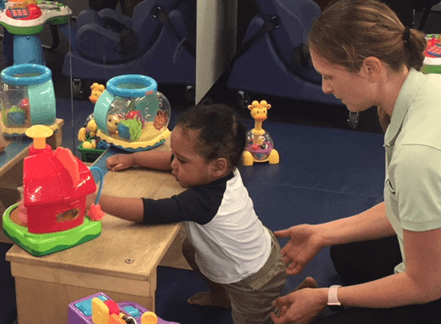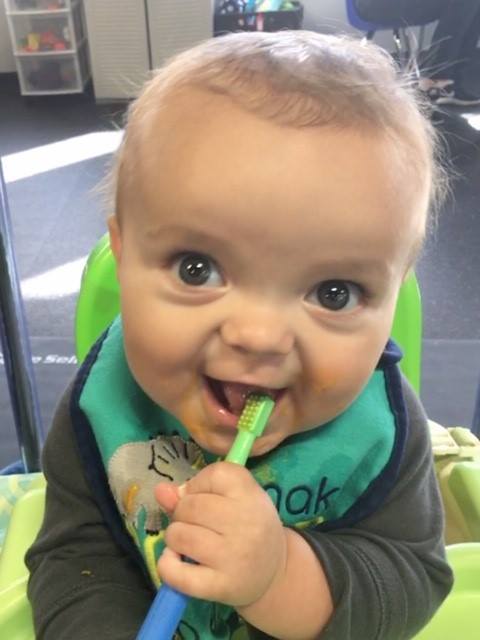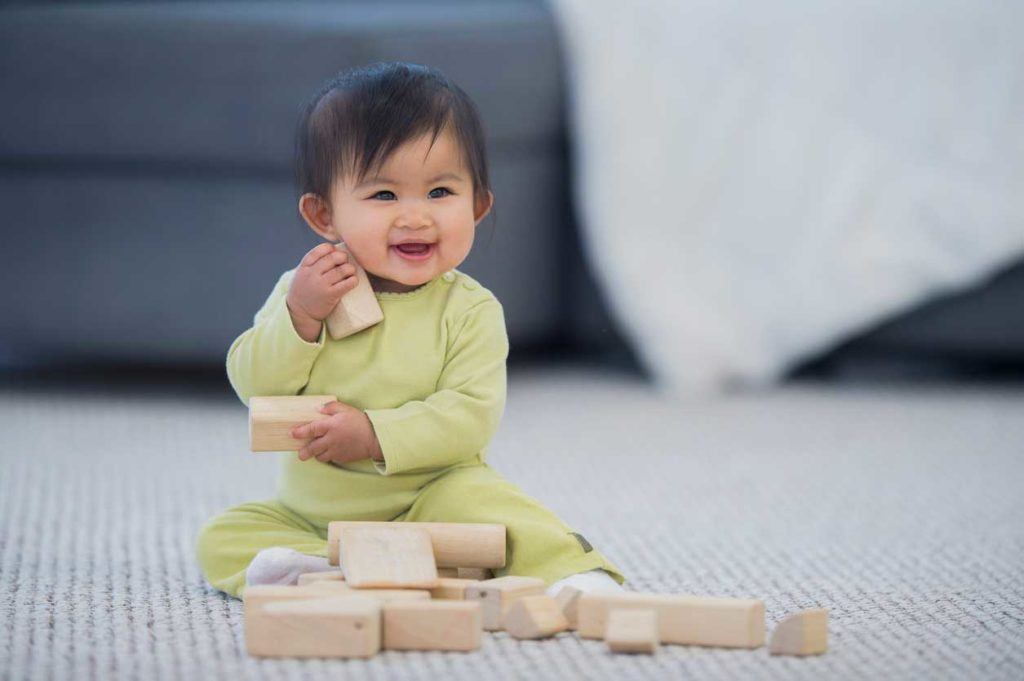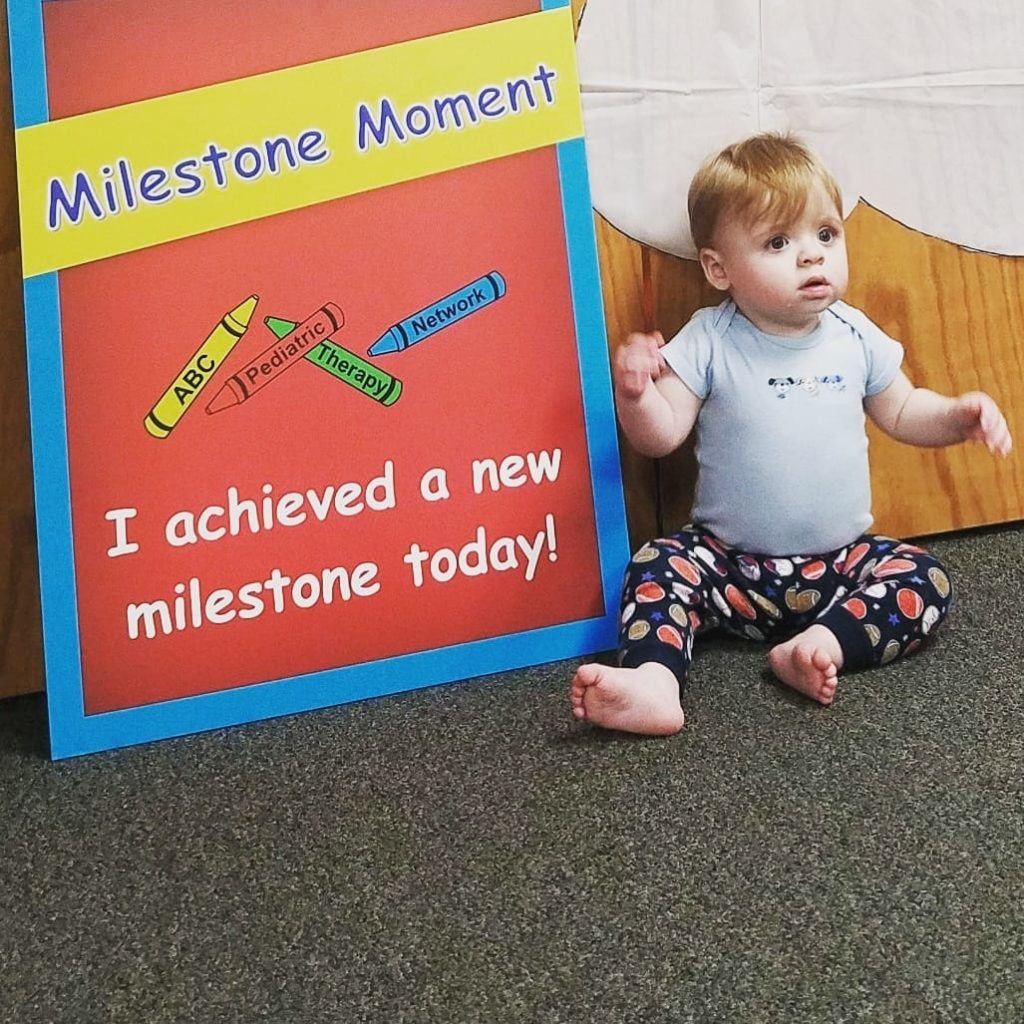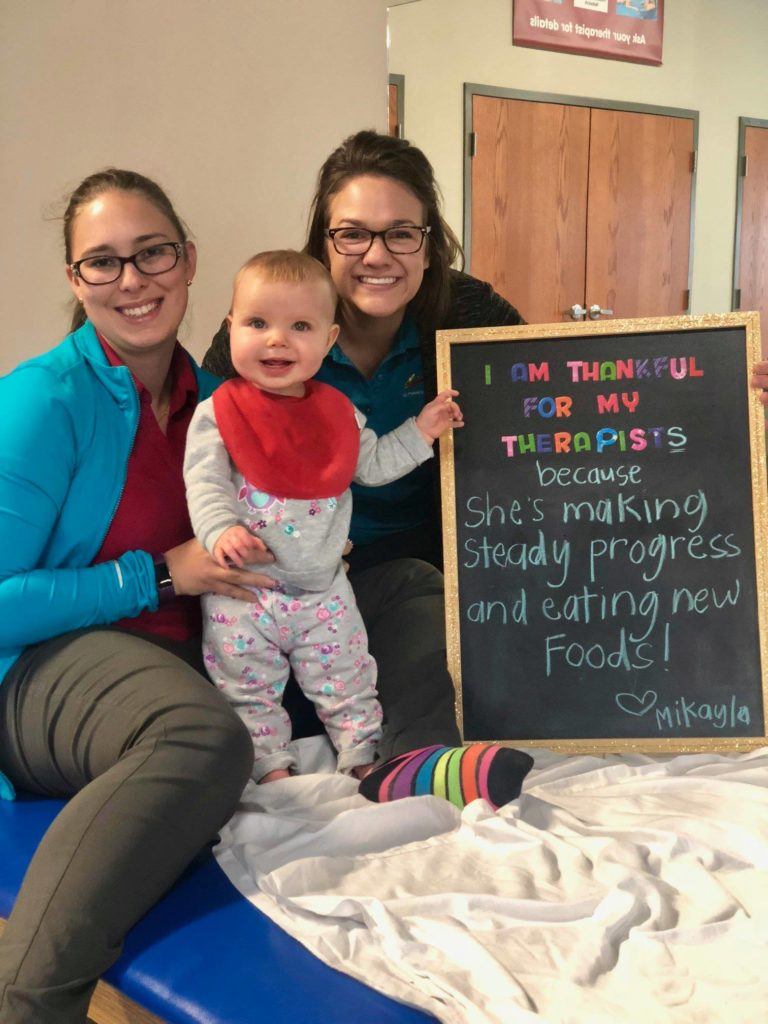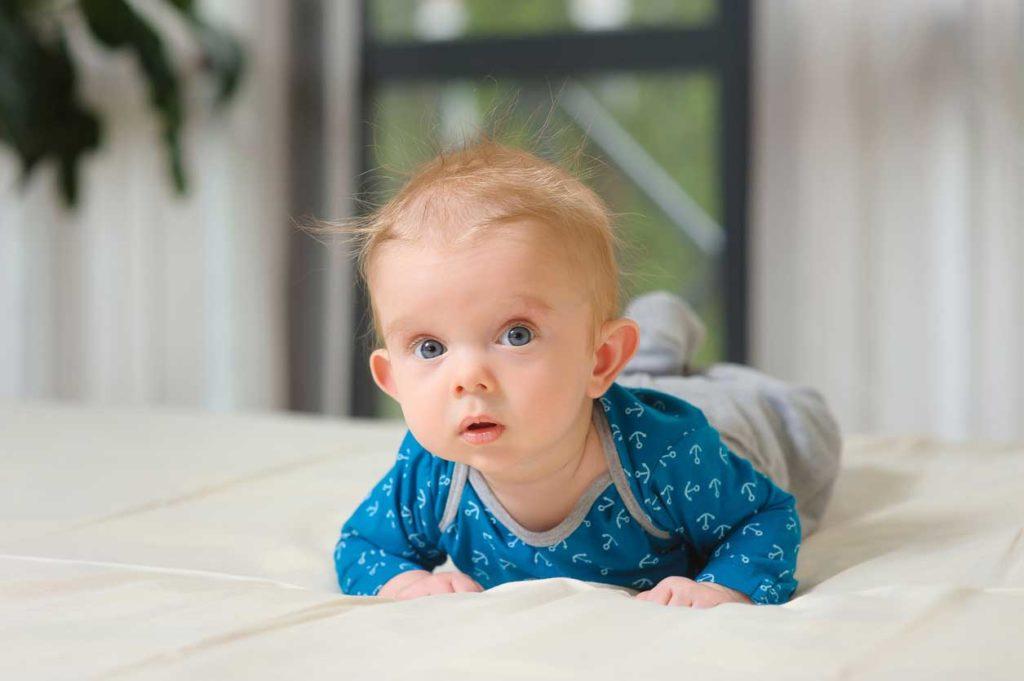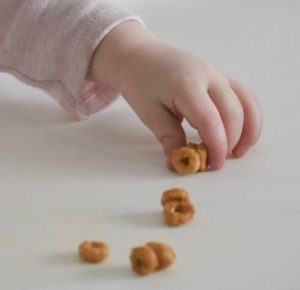Your Child’s First Year
Development during your child's first year is critical in future success. And while every child learns movements at an individual rate, developmental delays may cause concern and hardship. Use our guide below to see what milestones your child should be reaching at every stage during the first year. Milestones listed at each stage carry on through each subsequent phase of development (i.e. skills at 6 months should be present at 7 months).
Infant Milestones – 0 to 3 Months
- Expect your newborn to sleep most of the day.
- Tummy Time is so important - encourage your baby to play on his belly and look up at toys or you. Read this blog about why your child should be on their tummy! https://www.abcpediatrictherapy.com/tummy-time-tips-and-tricks/
- Holds head in the center when you pull them to sitting position
- Bends and straightens arms and legs when lying on his back
- Brings hands to midline while lying on her back
Important tip: limit the amount of time in positioning devices like bouncy seats, baby swings, car seats, strollers, etc. as this puts pressure on the back of the baby’s head and can lead to a flat spot on their head
- Brings hands to mouth for exploration
- Grasps rattle if placed in hand
- Reaches forward and touches toy
- Hits at dangling objects with hands
- Beginning to follow toys or parents with eyes
Interesting Fact: Did you know an infant this age has perfect hearing unless there are concerns?
- Newborns cry as their main form of communication. Your baby is saying they are hungry, tired, need a diaper change or just want your attention.
- Talk to your baby and repeat back any cooing sounds so your baby can hear them
- your child will be very curious and love interacting with you learning your voice and your expressions
- Your baby is not quite interested in toys yet – they’re most interested in your face!
Interesting Fact: Did you know an infant this age sees best 9-11 inches from their face?
- Your baby can briefly calm himself
- Cooing: vowel sounds
- Your baby relies on you for all of their self-care. Enjoy these times together! You can never love on your little one too much
- Sucks from breast or bottle
- Takes 2-6 ounces of liquid per feeding, at 6 or more feedings per day (1 month)
- Takes 7-8 ounces of liquid per feeding, at 4-6 feedings per day (3 months)
- Your baby will probably enjoy bath time - Snuggle in a towel when bath time is over!
- Able to calm with rocking, touching, and gentle sounds
- Enjoys a variety of movements
- Cries when startled
- Sleeps throughout most of the day about 1-2 hours at a time
- Will sleep a total of 14-17 hours
Interesting Fact: Did you know an infant this age has a fully developed sense of smell unless there are concerns?
- Gets fussy for attention
- Pays attention to faces
- Smile at your baby and encourage your baby to smile at you – she may begin smiling at 3 months
Interesting Fact: Did you know that infants as young as 2-3 months love the sound of music and will increase movement when music is turned on?
- YOU (most babies prefer people over toys)
- Black and White toys or bright colors
- Rattles
- Any toy that lights up and makes sounds
- Using a nursing pillow as a prop during supervised awake tummy time
Infant Milestones – 4 to 5 Months
- Bears weight on forearms when on belly, and lifts head up
- Holds head in midline
- Rolls from tummy to side or back to side
Interesting Fact: Did you know a baby at this age will reach out for a preferred toy?
Important tip: limit the amount of time in positioning devices like bouncy seats, baby swings, car seats, strollers, etc. as this puts pressure on the back of the baby’s head and can lead to a flat head in the back
- Bring hands together when lying on back
- Grasp rattle when placed in hand
- Reaches toward and touches toy
- Hits at dangling objects with hands
- Holds small object with palm and fingers, but not thumb (“palmar” grasp)
- Tracks fast moving objects with eyes
Interesting Fact: Did you know a baby at this age will repeat simple sounds like da, ba, ca without any particular meaning?
- Responds to a smile with a smile
- Likes looking at a human face most
- Cooing: vowel sounds
- Vocalizes some sounds
- Produces a variety of facial expressions
- Your baby relies on you for all of their self-care. Enjoy these times together! You can never love on your little one too much!
- Might start to hold on to bottle while drinking
- Holds own bottle with 1 or 2 hands
- May begin to introduce cereals or pureed
- May introduce cup
- Generally happy when not hungry or tired
- Is not upset by everyday sounds
- Enjoys a variety of movements May start sleeping 8-12 hours through the night
- Sleeps 12-16 hours for every 24 hours (including naps)
- Enjoys Peekaboo
- Turns head toward sounds
- Rattles
- Plush toys that are noisy or have texture
- Mirrors
- Light up or musical toys
- Activity mat for tummy time or supine play with grasping at toys and visual tracking
- Lightweight toys with easy to grasp holes (like an O-ball)
- Teething toys with different textures
Infant Milestones – 6 Months
- Sits alone for short periods
- Begins to belly crawl
- Rolls back to belly and belly to back
- Grabs feet and brings them to mouth
- Props up on straight elbows when lying on belly
- Inferior pincer grasp
Important tip: limit the amount of time in positioning devices like bouncy seats, baby swings, car seats, strollers, etc. as this puts pressure on the back of the baby’s head and can lead to a flat head in the back
- Puts fingers in mouth
- Reaches for a toy when playing on belly
- Holds a toy and shakes it
- Holds hands open at least ½ of the time
- Starting to explore and figure out how to activate toys
- Moves head to track fast moving objects or people with eyes, while on back and on belly
- Smiles at self in mirror
- Will repeat simple sounds again and again like dada, baba, mama without any particular meaning
Interesting Fact: Did you know a baby at this age understands the meaning of “no”?
- Your baby relies on you for all of their self-care. Enjoy these times together! You can never love on your little one too much!
- Might start to bring bottle toward mouth by self
- Your baby will enjoy bath time with you, this is a great bonding time!
- Put fingers in mouth
- Cup drinking is introduced
- Soft, smooth solids
- Moves chewed food to center of mouth before swallowing
- Gets bottle to mouth by self
- Your baby has full color vision at this age
- Is not upset by everyday sounds
- Enjoys a variety of movements, likes to be swung
- May start sleeping 8-12 hours through the night
- Sleeps 12-16 hours for every 24 hours (including naps)
- Enjoys Peekaboo
- Turns head toward sounds
- Generally happy when not hungry or tired
- Larger toys that your infant can sit at and play with
- Colorful toys
- Toys that light up and make sounds
- Cause and effect light up toys
- Shape sorters
- Stacking or nesting toys
- Musical instruments
- Small lightweight balls
Infant Milestones – 7 Months
- Reaching forward to grab toys while sitting and returning to sit
- Masters army crawl
- Attempts to get on hands and knees
- Rocking while on hands and knees
Important tip: try to avoid time in “containers,” like car seats, strollers, jumpers, or infant swings. “Containers” limit the amount of time and ability for a baby to kick, turn their head, wiggle, move and explore their environment as a baby is supposed to in order to develop the strength they will need to roll over, sit up, crawl and walk!
- Bangs a toy on the floor
- Passes a small object from one hand to the other
- Holds a toy in each hand and bangs together
- Learns to clap
- Inferior pincer grasp and lateral pincer grasp (can pick up a small item such as a cheerio using the side of the thumb and side of the finger)

- Turns head to visually track objects while sitting
- Turn taking “talking”
- Babbles some sounds repeatedly (baba or mama)
Interesting Fact: Did you know your baby will recognize how own name when called?
- Your baby relies on you for all of their self-care. Enjoy these times together! You can never love on your little one too much!
- Might start to bring bottle toward mouth by self
- Your baby will enjoy bath time with you, this is a great bonding time!
- Starts to self-feed finger foods
- Starts to self-feed finger foods
- Soft, smooth solids
- Eyes track 180 degrees from side to side while sitting
- Investigates shapes, sizes, and textures of toys and surroundings
- Enjoys a variety of movements – bouncing up and down, rocking back and forth
- May start sleeping 8-12 hours through the night – should have a reliable sleep schedule at this point
- Sleeps 12-16 hours for every 24 hours (including naps)
- Enjoys Peekaboo
- Wants to explore the environment
- Raises hands to be picked up
- Separation anxiety may start at this age
- Maintains eye contact with you while you’re playing
- Larger toys that your infant can sit at and play with
- Toys that light up and make sounds
- Cause and effect light up toys
- Shape sorters
- Stacking or nesting toys
- Musical instruments
- Small lightweight balls
Infant Milestones – 8 Months
- Able to get into and out of sitting position
- Gets on hands and knees and rocks
- Stands when placed at furniture
Important tip: try to avoid time in “containers,” like car seats, strollers, jumpers, or infant swings. “Containers” limit the amount of time and ability for a baby to kick, turn their head, wiggle, move and explore their environment as a baby is supposed to in order to develop the strength they will need to roll over, sit up, crawl and walk!
- Grasps two toys in one hand
- Inferior pincer grasp and lateral pincer grasp (can pick up a small item such as a cheerio using the side of the thumb and side of the finger)
- Turns head to visually track objects while sitting
- Produces sounds which are similar to t, d, f, v, z, ch, j, th, sh, and s
- Your baby relies on you for all of their self-care. Enjoy these times together! You can never love on your little one too much!
- Might start to bring bottle toward mouth by self
- Your baby will enjoy bath time with you, this is a great bonding time!
- Starts to use finger foods
- Feeds self finger foods
- Soft, smooth solids
- Mashed table foods
- Eyes follow a falling object when dropped
- Investigates shapes, sizes, and textures of toys and surroundings
- Enjoys a variety of movements – bouncing up and down, rocking back and forth
- May start sleeping 8-12 hours through the night – should have a reliable sleep schedule at this point
- Sleeps 12-16 hours for every 24 hours (including naps)
- Enjoys Peekaboo
- Wants to explore the environment
- Raises hands to be picked up
- Separation anxiety may start at this age
- Maintains eye contact with you while you’re playing
- Teething toys
- larger toys that your infant can sit at and play with
- Toys that light up and make sounds
- Cause and effect light up toys
- Shape sorters
- Stacking or nesting toys
- Musical instruments
- Small lightweight balls
Infant Milestones – 9 Months
- Crawls independently
- Scoots forward in sitting
- Pulls to stand from floor at furniture
- Able to get into and out of all-fours position from sitting
- Pivots in sitting 90 degrees to both sides
Interesting Fact: Did you know at this age a child has Object Permanence – the ability to realize an object still exist when hidden?
Important tip: try to avoid time in “containers,” like car seats, strollers, jumpers, or infant swings. “Containers” limit the amount of time and ability for a baby to kick, turn their head, wiggle, move and explore their environment as a baby is supposed to in order to develop the strength they will need to roll over, sit up, crawl and walk!
- Begins to help with dressing by reaching/lifting arm or leg
- Enjoys stacking toys or put 1 toy in another like stacking cups
- Releases objects intentionally
- Pulls on a string to get a toy
- Picks up, pushes, or shoves fairly large objects
- Bangs a toy on the floor
- Passes a small object between hands
- Picks up small objects between fingertips and thumb, with a space between the object and palm (pincer grasp)
- Turns head to visually track objects while sitting
- Waves bye-bye
- Babbles some sounds
- Responds to “no”
- Interesting Fact: Did you know a child at this age will shake their head “no” and mean “no”?
- Vocalizes different syllables
- Your baby relies on you for all of their self-care. Enjoy these times together! You can never love on your little one too much!
- Brings bottle toward mouth by self
- Your baby will enjoy bath time with you, this is a great bonding time!
- Starts to use finger foods
- Cereals and pureed foods are introduced
- Feeds self finger foods
- Makes sounds while eating with food and mouth
- Cup is introduced for liquids
- Holds bottle and tips it up
- Tolerates smooth, lumpy solids fed by spoon
- Enjoys a variety of movements – bouncing up and down, rocking back and forth
- Investigates shapes, sizes, and textures of toys and surroundings
- Should start sleeping 8-12 hours through the night – should have a reliable sleep schedule at this point
- Sleeps 12-16 hours for every 24 hours (including naps)
- Enjoys Peekaboo
- Wants to explore the environment
- Raises hands to be picked up
- Separation anxiety may start at this age
- Maintains eye contact with you while you’re playing
- Cardboard books
- Toys that light up and make sounds
- Cause and effect light up toys
- Shape sorters
- Stacking or nesting toys
- Musical instruments
- Toys that move when pushed so the child can go after the toy
- Large balls
- Toddler activity table for standing and cruising around
Tip: place toys on chairs and couches to encourage your child to stand
Interesting Fact: Did you know that a child may develop favorite toys at this age?
Infant Milestones – 10 Months
- Crawls up a few steps
- Creeps over your legs
- Walks with 2 hands held
- Begins cruising along furniture a few steps
- Able to get into sitting position from lying on back
- Lowers to sitting from standing position
- Climbs onto furniture/chairs
- Tolerates standing at furniture for a few minutes while playing
Interesting Fact: Did you know that a child can play simple games like Peek a Boo and Patty Cake?
Important tip: try to avoid time in “containers,” like car seats, strollers, jumpers, or infant swings. “Containers” limit the amount of time and ability for a baby to kick, turn their head, wiggle, move and explore their environment as a baby is supposed to in order to develop the strength they will need to roll over, sit up, crawl and walk!
- Picks up small object with improved pincer grasp
- Grasps with thumb and first 2 fingers (3 jaw chuck)
- Begins turning page in cardboard book
- Removes things form containers, picking out or dumping them
- Pays attention to where you are looking and pointing
Fun Fact: Your child may like to knock down toys that you stack like blocks or nesting cups.
- Waves bye-bye
- Babbles some sounds
- Responds to “no”
- Vocalizes different syllables
- Your baby relies on you for all of their self-care. Enjoy these times together! You can never love on your little one too much!
- Brings bottle toward mouth by self
- Your baby will enjoy bath time with you, this is a great bonding time!
- Starts to use finger foods
- Begins feeding self with hands
Interesting Fact: Did you know that a child this age can follow simple instructions like “pick up the book” or “come to daddy”?
- Looks closely at tiny object
- Enjoys listening to songs
- Explores toys with hands, fingers, and mouth
- Should start sleeping 8-12 hours through the night and have a reliable sleep schedule
- Sleeps 12-16 hours for every 24 hours (including naps)
- Starts to point at things he wants
- Likes to explore the environment when placed on the floor
- Maintains eye contact with you
- Will turn head in response to hearing name
- Cardboard books
- Toys that light up and make sounds
- Cause and effect light up toys
- Shape sorters
- Stacking or nesting toys
- Musical instruments
- Toys that move when pushed so the child can go after the toy
- Large balls
- Walkers and push toys
- Toddler activity table for standing and cruising around
Infant Milestones – 11 Months
- Cruising on and between furniture
- May begin to stand without support for a couple seconds
- Walks holding 1-2 hands
- Walks with a push toy
- Bends down to pick up a toy while holding on to furniture
Important tip: try to avoid time in “containers,” like car seats, strollers, jumpers, or infant swings. “Containers” limit the amount of time and ability for a baby to kick, turn their head, wiggle, move and explore their environment as a baby is supposed to in order to develop the strength they will need to roll over, sit up, crawl and walk!
- Tears paper
- Pokes into holes with index finger
- Can open and close drawers/doors or uses switches to turn on and off
- Throws things just to see what happens
- Pays attention to where you are looking and pointing
Interesting Fact: Did you know a child this age begins to prefer building versus knocking down?
- Able to point to body parts
- Your baby relies on you for all of their self-care. Enjoy these times together! You can never love on your little one too much!
- Brings bottle to mouth by self
- Your baby will enjoy bath time with you, this is a great bonding time!
- Starting to use finger foods, feeds self with hands
- Takes socks off
- Feeding self with hands
- Enjoys water play
- Enjoys listening to songs
- Explores toys with hands, fingers, and mouth
- Should start sleeping 8-12 hours through the night and have a reliable sleep schedule
- Sleeps 12-16 hours for every 24 hours (including naps)
- Starts to point at things he wants
- Likes to explore the environment when placed on the floor
- Maintains eye contact with you
- Will turn head in response to hearing name
- Cardboard books
- Toys that light up and make sounds
- Cause and effect light up toys
- Shape sorters
- Stacking or nesting toys
- Musical instruments
- Toys that move when pushed so the child can go after the toy
- Large balls
- Walkers and push toys
Infant Milestones – 12 Months
- Independent standing
- Cruises along furniture independently and quickly
- Walks pushing a toy with wheels like a grocery cart
- Begins to take first steps between 12-15 months
- Corrals a ball with arms and hands in sitting
- Throws a ball
- Transitions to standing without furniture support
Important tip: try to avoid time in “containers,” like car seats, strollers, jumpers, or infant swings. “Containers” limit the amount of time and ability for a baby to kick, turn their head, wiggle, move and explore their environment as a baby is supposed to in order to develop the strength they will need to roll over, sit up, crawl and walk!
- Builds 2 block tower
- Can place small objects in a bottle
- Grasp thick crayon or pencil in fist, but may not mark on paper
- Turns page of cardboard book
- Puts objects into container
- Pays attention to where you are looking and pointing
- Says about 3 words like mama, dada, dog
- Babbles using different sounds
- Takes turns vocalizing
- Points/gestures
- A child understands a much greater number of words than they can say at this age - So name everything in their world and read lots of books.
Interesting Fact: Did you know that a child at this age can follow simple directions like “bring me a diaper” or “Take your shoes to your dad”?
- Your baby relies on you for all of their self-care. Enjoy these times together! You can never love on your little one too much!
- Brings bottle to mouth by self
- Your baby will enjoy bath time with you, this is a great bonding time!
- Starting to use finger foods, feeds self with hands
- Helps to pull off simple clothing
- Pulls off socks and shoes
- Feeding self with fingers
- Tolerates coarsely chopped food
- Enjoys listening to songs
- Explores toys with hands, fingers, and mouth
- Should start sleeping 8-12 hours through the night and have a reliable sleep schedule
- Sleeps 12-16 hours for every 24 hours (including naps)
- Starts to point at things he wants
- Likes to explore the environment when placed on the floor
- Maintains eye contact with you
- Will turn head in response to hearing name
- Small blocks
- Cardboard books
- Toys that light up and make sounds
- Cause and effect light up toys
- Shape sorters
- Stacking or nesting toys
- Musical instruments
- Toys that move when pushed so the child can go after the toy
- Large balls
Red Flags for Development in the First Year
- Does not tolerate tummy time
- Head shape deformities
- Make sure to limit the amount of time in positioning devices like bouncy seats, baby swings, car seats, strollers, etc. as this puts pressure on the back of the baby’s head and can lead to a flat head in the back
- Not making eye contact
- Not turning to sounds or responding to loud sounds
- Not communicating
- Put the phone down – talk to your kiddo!
- Do not let older siblings talk for younger siblings
- Infant has difficulty keeping eyes or head in midline
- Preference for tilting or turning head to one side
- Stiff or shaky movements
- Stiff joints
- Too “floppy”
- Inconsolable crying
- Not consistently gaining weight
With a strong foundation, your infant will be ready for the next stages of moving and talking.
Help your child find new levels of independence with pediatric therapy in Cincinnati and Dayton, OH.
 Skip to content
Skip to content

